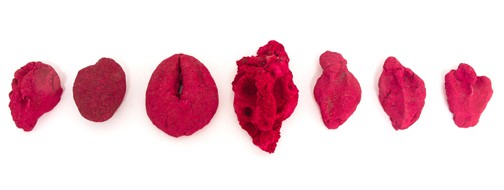Archeology of the Future
“I see the sculptures as self-portraits, especially because they are so bodily,” says Toronto-based artist Jasmine Reimer. “I don’t see my body specifically, or even the female body generally, but I see this embodied feeling within them. It’s like I see a sensation.” For Reimer, even the optic is tactile.
It works that way for the viewer as well. Looking at her work is a visceral engagement. The surfaces of her standing sculptures (which start out as plastic Diaper Genies) are an intriguing combination of the seductive and the repulsive. The sculptures in “Small Obstructions,” her recent exhibition at Georgia Scherman Projects in Toronto, are composed of sand, dye, papier mâché, wood and found objects. The majority of the objects are foodstuff, including blueberries, avocados, figs, dates, raisins and dark chocolate, all of which she casts in rubber. They are the first things to be made and applied.

The Savages, 2017, sand, papier mâché, dye, glue, dimensions variable.
The uniform surface of Promises & Threats 1, a particularly attractive black sand sculpture, is interrupted by ruby-red cherry tomatoes that push through the dark sand as if they were decorative jewels. Reimer sees them as a disruption, like eyeballs or testicles. For her, the protrusion—“something that goes outward instead of inward”—is the opposite of a hole. She has been concerned for some time with the idea of the grotesque and its capacity to break boundaries. In reading Rosi Braidotti she discovered generative overlaps between the features of the traditional grotesque and feminist theories of the body. “They both stand for fluidity and boundary-breaking and flux and nomadism—all states of transience, all the time, never one place, always the other, continually bouncing between identities.”
In her collection of poetry, also called Small Obstructions, Reimer opens “The Best Part of Suffering” with the line, “I want there to be holes in everything.” More than a line of poetry, it becomes an aesthetic methodology. “I don’t think you can have an intimate experience, whether sexual or not, that doesn’t open up to the inside. That opening goes back to the impetus behind the grotesque, which is to make everything base material. There is nothing too lofty not to be returned to the earth and to the body. I think a lot of what I do is really, really primitive.”
The sand in Guilty Pleasures 2 (Mount Sin) is dyed brown and the surface-rupturing protuberances are cast rubber chocolates and figs. In Thoughts All Sizes 2 the base of the sculpture is dotted with cast blueberries, while a single silicone-covered leaf sits on top. These columnar sculptures are confusingly beautiful. The smaller pieces work the same way. All these sculptures have about them a quality of timelessness. The Hermits and The Hollows look like they have been pulled from the earth after a long burial, as if they were artifacts of an archeology from the future. That they’re made from the discarded tops and guts of the Diaper Genies makes their transformation even more delightfully improbable. Reimer wants to use familiarity to make something unfamiliar. In that sense, the super-sleek, curved white cylinder of the diaper container is a perfect armature to represent what she calls “cross-wired eroticism.”

Thoughts All Sizes 2, 2017, sand, dye, papier mâché, rubber, found object, wood, leaf, silicone, 37 x 19.5 x 19.5 inches.
_2_2017_360_540_90.jpg)
Guilty Pleasures 2 (Mount Sin), 2017, sand, papier mâché, dye, rubber, found object, 29 x 11 x 9 inches.
Her interest in embodied subjectivity offers tantalizing insights into “what the female body stands for now and how it could be positioned in the future.” But that figuring out is being conducted in the absence of the figure. “I have chosen to deal with a bodily state without ever actually rendering a body part,” she says. Her sculptures are metonymies for that physical presence and our impulse is to touch them. It is an inclination she understands because she has said that the only way she knows something is if she touches it. But when asked if she wants her sculptures to be handled, she reframes the question. “You could shorten it to, ‘I want people to want.’”
In making and writing, what motivates her is desire. “I would say that three-quarters of the time I am in some state of desire, and that’s a very unrestful place to be. I make sculpture to try and describe this state. Poetry works really well in doing that because I can project words onto things in the world that I think represent this continuous desired state.”

Installation view, 2017.
Within that round of desire, Reimer views her sculpture practice as a ritual. “I’m trying to summon something that doesn’t exist in the rest of my life in that specfic way. Making sculpture is a very specific set of actions that have a distinct feel. It’s not like other things. I use music and other people’s writing and work to motivate or unleash something, I think all rituals are a summoning. Or perhaps a pacifying.” In her irresistible sculptures you could say Jasmine Reimer is making a special form of piece. ❚

